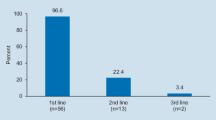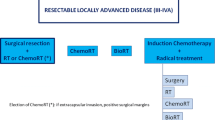Abstract
Background
The treatment of head and neck squamous cell carcinoma (HNSCC) is highly complex and requires a multimodal approach. However, guidelines for the treatment of most forms of HNSCC do not exist in German-speaking countries with the exception of oral cavity cancer. The aim of this cross-sectional study was to describe the current treatment landscape and infrastructure in German-speaking countries.
Methods
From November 2013 to July 2014, 204 departments of otorhinolaryngology (ORL) in Germany, Austria, and the German-speaking part of Switzerland were contacted and invited to take part in a web-based survey on the treatment of HNSCC. In order to cover the study in its entirety, we published three consecutive papers of which this paper is the first.
Results
In all, 62 treatment centers (30.4 %) participated in the survey. These centers included 21 university hospitals, 16 certified cancer centers, and 35 large centers, which diagnose at least 75 HNSCC patients annually. In 91.9 % of all cases, there were outpatient consultation hours (that were monodisciplinary in 61.4 %). A multidisciplinary tumor board was existent in 98.4 % of the cases. Of 62 ORL departments, 50 had a hospital cancer registry, 41 of 62 conducted oncological studies, and 35 of 62 assessed their patients’ quality of life.
Conclusion
The infrastructure of the treatment for HNSCC can be considered mostly well-developed and supports interdisciplinary cooperation. Potential improvements can be made regarding the standardization of tumor boards, the participation in clinical trials, and the availability of cancer registries and the data gathered therein.
Zusammenfassung
Hintergrund
Die Behandlung von Plattenepithelzellkarzinomen im Kopf-Hals-Bereich (HNSCC) ist hochkomplex und erfordert häufig einen multimodalen Therapieansatz. Neben der operativen Therapie und Bestrahlung stehen auch konkurrierende systemische Therapiekonzepte wie die antineoplastische Chemotherapie zur Verfügung. Trotz der Komplexität der Behandlung fehlen, mit Ausnahme der Leitlinie zur Behandlung von Mundhöhlenkarziomen, einheitliche Leitlinien. Das Ziel dieser Querschnittsuntersuchung war, die derzeitige Behandlungslandschaft und Infrastruktur im deutschsprachigen Raum darzustellen.
Material und Methoden
Von November 2013 bis Juli 2014 wurden 204 HNO-Kliniken in Deutschland, Österreich und der deutschsprachigen Schweiz kontaktiert und zur Teilnahme an einer webbasierten Umfrage zur Tumortherapie von HNSCC aufgefordert.
Ergebnisse
Von 204 HNO-Kliniken partizipierten 62 (30,4 %). Unter diesen 62 Behandlungszentren sind 21 Universitätskliniken, 16 zertifizierte Krebszentren und 35 große Zentren, die jährlich mindestens 75 Patienten mit Erstdiagnose eines Plattenepithelzellkarzinoms des Larynx, Pharynx oder der Mundhöhle diagnostizieren. In 57/62 HNO-Kliniken gibt es eine Tumorsprechstunde, die in 35/57 Fällen monodisziplinär ist. Ein multidisziplinäres Tumorboard existiert in 61/62 Kliniken. 50/62 HNO-Kliniken haben ein klinisches Krebsregister, und die Zusatzbezeichnung medikamentöse Tumortherapie ist in 23/62 Kliniken vorhanden. Onkologische Studien werden in 41/62 und die Erhebung der Lebensqualität in 35/62 Behandlungszentren durchgeführt.
Schlussfolgerung
Die Umfrage ergab, dass die Infrastruktur für die Behandlung von HNSCC in vielen Bereichen gut entwickelt ist und eine interdisziplinäre Kooperation unterstützt. Verbesserungspotenzial gibt es bei der Standardisierung von Tumorboards, der Teilnahme an klinischen Studien sowie der Verfügbarkeit von Krebsregistern und daraus erhobener Daten.



Similar content being viewed by others
References
Adelstein DJ, Li Y, Adams GL et al (2003) An intergroup phase III comparison of standard radiation therapy and two schedules of concurrent chemoradiotherapy in patients with unresectable squamous cell head and neck cancer. J Clin Oncol 21:92–98
Curran D, Giralt J, Harari PM et al (2007) Quality of life in head and neck cancer patients after treatment with high-dose radiotherapy alone or in combination with Cetuximab. J Clin Oncol 25:2191–2197
De Bree R, Putten LVD, Brouwer J et al (2009) Detection of locoregional recurrent head and neck cancer after (chemo)radiotherapy using modern imaging. Oral Oncology 45:386–393
De Casso C, Visvanathan V, Soni-Jaiswall A et al (2012) Predictive value of positron emission tomography – computed tomography image fusion in the diagnosis of head and neck cancer: does it really improve staging and management? J Laryngol Otol 126:295–301
Evangelista L, Cervino AR, Chondrogiannis S et al (2014) Comparison between anatomical cross-sectional imaging and 18F-FDG PET/CT in the staging, restaging, treatment response, and long-term surveillance of squamous cell head and neck cancer: a systematic literature overview. Nucl Med Commun 35:123–134 (110.1097/MNM.0000000000000022)
Guntinas-Lichius O, Rühlow S, Veelken F et al (2009) Quality of life during first-line palliative chemotherapy for recurrent and metastatic head and neck cancer with weekly cisplatin and docetaxel. J Cancer Res Clin Oncol 135:901–908
Guntinas-Lichius O, Wendt T, Buentzel J et al (2010) Head and neck cancer in Germany: a site-specific analysis of survival of the Thuringian cancer registration database. J Cancer Res Clin Oncol 136:55–63
Haddad R, O’Neill A, Rabinowits G et al (2013) Induction chemotherapy followed by concurrent chemoradiotherapy (sequential chemoradiotherapy) versus concurrent chemoradiotherapy alone in locally advanced head and neck cancer (PARADIGM): a randomised phase 3 trial. Lancet Oncol 14:257–264
Kaatsch P, Spix C, Hentschel S et al (2013) Beiträge zur Gesundheitsberichterstattung des Bundes – Krebs in Deutschland 2009/2010. Robert-Koch-Institut, Berlin
Kuhn FP, Hüllner M, Mader CE et al (2014) Contrast-enhanced PET/MR imaging versus contrast-enhanced PET/CT in head and neck cancer: How much MR information is needed? J Nucl Med 55:551–558
Mesía R, Rivera F, Kawecki A et al (2010) Quality of life of patients receiving platinum-based chemotherapy plus cetuximab first line for recurrent and/or metastatic squamous cell carcinoma of the head and neck. Ann Oncol 21:1967–1973
Murphy BA, Gilbert J, Cmelak A et al (2007) Symptom control issues and supportive care of patients with head and neck cancers. Clin Adv Hematol Oncol 5:807–822
Nguyen NP, Vos P, Lee H et al (2008) Impact of tumor board recommendations on treatment outcome for locally advanced head and neck cancer. Oncology 75:186–191
Pignon J‑P, Maître AL, Maillard E et al (2009) Meta-analysis of chemotherapy in head and neck cancer (MACH-NC): an update on 93 randomised trials and 17,346 patients. Radiother Oncol 92:4–14
Pignon JP, Bourhis J, Domenge C et al (2000) Chemotherapy added to locoregional treatment for head and neck squamous-cell carcinoma: three meta-analyses of updated individual data. Lancet 355:949–955
Psyrri A, Licitra L, Lacombe D et al (2010) Strategies to promote translational research within the European Organisation for Research and Treatment of Cancer (EORTC) Head and Neck Cancer Group: a report from the Translational Research Subcommittee. Ann Oncol 21:1952–1960
Singer S, Arraras JI, Baumann I et al (2013) Quality of life in patients with head and neck cancer receiving targeted or multimodal therapy – Update of the EORTC QLQ-H&N35, Phase I. Head Neck 35:1331–1338
Van Herpen CML, Mauer ME, Mesia R et al (2010) Short-term health-related quality of life and symptom control with docetaxel, cisplatin, 5‑fluorouracil and cisplatin (TPF), 5‑fluorouracil (PF) for induction in unresectable locoregionally advanced head and neck cancer patients (EORTC 24971/TAX 323). Br J Cancer 103:1173–1181
Wheless SA, Mckinney KA, Zanation AM (2010) A prospective study of the clinical impact of a multidisciplinary head and neck tumor board. Otolaryngol – Head Neck Surg 143:650–654
Acknowledgements
We greatly appreciate the time spent by all participating treatment centers for the completion of our survey and want to thank them for their detailed responses.
Author information
Authors and Affiliations
Corresponding author
Ethics declarations
Conflict of interest
R. Knecht is a member of the scientific advisory board for Merck Serono, Sanofi Aventis, Boehringer Ingelheim, and Bayer Healthcare Leverkusen. J. Kimmeyer, T. Kurzweg, T. K. Hoffmann, J. A. Veit, N. Möckelmann, A. Münscher, and S. Laban state that there are no conflicts of interest.
The accompanying manuscript does not include studies on humans or animals.
Additional information
Dieser Beitrag ist als eine Originalarbeit anzusehen und aus formalen Gründen im Leitthema dieser Ausgabe eingeordnet.
This article should be considered an original contribution and has been classified for technical reasons as a main topic.
J. Kimmey and T. Kurzweg contributed equally to this work and share first authorship.
Rights and permissions
About this article
Cite this article
Kimmeyer, J., Kurzweg, T., Hoffmann, T.K. et al. Oncologic treatment landscape for head and neck squamous cell carcinoma. HNO 64, 494–500 (2016). https://doi.org/10.1007/s00106-016-0188-9
Published:
Issue Date:
DOI: https://doi.org/10.1007/s00106-016-0188-9




